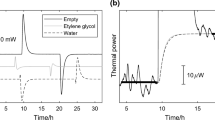Abstract
A simple, theoretically sound method for eliminating the effects of internal heat absorption on rate of heat release is described for the Ohio State University (OSU) Release Rate apparatus. By monitoring the temperature of metal walls and calculating the heat loss to surroundings caused by changes in wall temperature due to heat absorption, a complete energy balance on the system allows the calculation of a true heat of release rate.
Similar content being viewed by others
References
Smith, E. E. “Measuring Rate of Heat, Smoke, and Toxic Gas Release,”Fire Technology Vol.8, No. 3 (August 1972), p.237.
Smith, E. E., Heibel, J. T. “Evaluating Performance of Cellular Plastics in Fire Systems,” Final Report, PRC Project RP-75-36 (1977), p.19.
Evans, D., and Brenden, L. “Time Delay Correction for Heat Release Rate Data,”Fire Technology Vol. 14, No.2 (May 1978), p. 85.
ASTM E 906: “Test Method for Heat and Visible Smoke Release Rates for Materials and Products,” ASTM Fire Test Standards, 4th Edition, ASTM, Philadelphia, Pa., 1993, pp. 877–892.
Abramowitz, A., Lyon, R., “Comparison of Heat Release Rate from OSU and Oxygen Consumption Principle Calorimeter Signals,” Proceedings of the 2nd Fire & Flammability Conference, Communications, London England, 1993, p.161.
Krause, R. F., and Gann, R. G., “Rate of Heat Release Measurements Using Oxygen Consumption,”Journal of Fire and Flammability Vol. 11 (April 1980), p.117.
Babrauskas, V. “Performance of the OSU Rate of Heat Release Apparatus Using PMMA and Gaseous Fuels,”Fire Safety Journal Vol. 5 (1982), p. 9.
Tran, H. C., “Modifications to an Ohio State University Apparatus and Comparison with Cone Calorimeter Results,” AIAA/ASME Proceedings, Seattle, WA, 1990.
Blomqvist, J. “RHR of Building Materials-Experiments with an OSU Apparatus Using Oxygen Consumption,” Report LUTVDG/TVBB 3017, Lund Institute of Technology, Lund, Sweden, 1983.
Tsuchiya, Y., Mathieu, J. F., “Measuring Degrees of Combustibility Using OSU Apparatus and Oxygen Depletion Principle,” International Conference on Fires in Buildings, Technomic Publications, Lancaster Pa. (1989) p.27.
Aircraft Material Fire Test Handbook, Chapter 5, Federal Aviation Administration, U.S. Department of Transportation, FAA Technical Center, Atlantic City International Airport, N.J., p. 5.1.
ASTM E 1354: “Test Method for Heat and Visible Smoke Release Rates for Materials and Products Using and Oxygen Consumption Calorimeter,” ASTM Fire Test Standards, 4th Edition, ASTM, Philadelphia, PA., 1993, pp. 968–984.
Author information
Authors and Affiliations
Rights and permissions
About this article
Cite this article
Smith, E.E. Heat release rate calorimetry. Fire Technol 32, 333–347 (1996). https://doi.org/10.1007/BF01037743
Issue Date:
DOI: https://doi.org/10.1007/BF01037743



